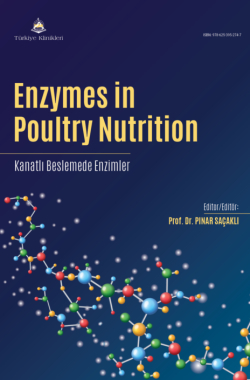Biotechnology of Enzyme Production
Cem ALBAYRAKa,b
aBezmiâlem Vakıf University Beykoz Institute of Life Sciences and Biotechnologies, Department of Biotechnology, İstanbul, Türkiye
bLivzym Biotechnologies, Inc., İstanbul, Türkiye
Albayrak C. Biotechnology of enzyme production. In: Saçaklı P, ed. Enzymes in Poultry Nutrition. 1st ed. Ankara: Türkiye Klinikleri; 2024. p.74-9.
ABSTRACT
Industrial enzymes, one of the many value-added chemicals enabled by the advent of recombinant DNA technology, are used as important additives in a variety of industries. In poultry nutrition, for example, phytases are an indispensable part of the feed composition and provide numerous benefits. In this review, the production process of enzymes is discussed along with technical considerations that go into design choices. Different parts of the process and the operations therein are described in considerable detail. The reader should come away from this chapter with a good understanding of the overall process flow.
Keywords: DNA, recombinant; enzymes; industrial biotechnology
Kaynak Göster
Referanslar
- Cowieson AJ, Wilcock P, Bedford MR. Super-dosing effects of phytase in poultry and other monogastrics. Worlds Poult Sci J. 2011;67(2):225-36. [Crossref]
- Romano N, Kumar V. Phytase in animal feed. In: Nunes CS, Kumar V, eds. Enzymes in Human and Animal Nutrition. 1st ed. London, UK: Academic Press; 2018. p.73-88. [Crossref] [PubMed] [PMC]
- Dersjant-Li Y, Awati A, Schulze H, Partridge G. Phytase in non-ruminant animal nutrition: a critical review on phytase activities in the gastrointestinal tract and influencing factors. J Sci Food Agric. 2015;95(5):878-96. [Crossref] [PubMed] [PMC]
- Sommerfeld V, Schollenberger M, Kühn I, Rodehutschord M. Interactive effects of phosphorus, calcium, and phytase supplements on products of phytate degradation in the digestive tract of broiler chickens. Poult Sci. 2018;97(4):1177-88. [Crossref] [PubMed] [PMC]
- Cowieson AJ, Aureli R, Guggenbuhl P, Fru-Nji F. Possible involvement of myo-inositol in the physiological response of broilers to high doses of microbial phytase. Anim Prod Sci. 2015;55:710-9. [Crossref]
- Gonzalez-Uarquin F, Rodehutscord M, Huber K. Myo-inositol: its metabolism and potential implications for poultry nutrition-a review. Poult Sci. 2020;99(2):893-905. [Crossref] [PubMed] [PMC]
- Singh R, Kumar M, Mittal A, Mehta PK. Microbial enzymes: industrial progress in 21st century. 3 Biotech. 2016;6(2):174. [Crossref] [PubMed] [PMC]
- Park SH, Na Y, Kim J, Kang SD, Park K-H. Properties and applications of starch modifying enzymes for use in the baking industry. Food Sci Biotechnol. 2018;27(2):299-312. [Crossref]
- Velázquez-De Lucio BS, Hernández-Domínguez EM, Villa-García M, Díaz-Godínez G, Mandujano-Gonzalez V, Mendoza-Mendoza B, et al. Exogenous Enzymes as Zootechnical Additives in Animal Feed: A Review. Catalysts. 2021;11(7):851. [Crossref]
- Valente Junior DT, Genova JL, Kim SW, Saraiva A, Rocha GC. Carbohydrases and Phytase in Poultry and Pig Nutrition: A Review beyond the Nutrients and Energy Matrix. Animals. 2024;14:226. [Crossref] [PubMed] [PMC]
- Soccol CR, Ferreira da Costa ES, Letti LAJ, Karp SG, Woiciechowski AL, Vandenberghe LPdS. Recent developments and innovations in solid state fermentation. Biotechnol Res Innov. 2017;1(1):52-71. [Crossref]
- Thomas L, Larroche C, Pandey A. Current developments in solid-state fermentation. Biochem Eng J. 2013;81:146-61. [Crossref]
- Meyer V, Fiedler M, Nitsche B, King R. The Cell Factory Aspergillus Enters the Big Data Era: Opportunities and Challenges for Optimising Product Formation. In: Krull R, Bley T, eds. Filaments in Bioprocesses. Advances in Biochemical Engineering/Biotechnology, vol 149. Cham, Switzerland: Springer International Publishing; 2015. p.91-132. [Crossref] [PubMed]
- Arnau J, Yaver D, Hjort CM. Strategies and Challenges for the Development of Industrial Enzymes Using Fungal Cell Factories. In: Nevalainen H, ed. Grand Challenges in Fungal Biotechnology. Grand Challenges in Biology and Biotechnology. Cham, Switzerland: Springer International Publishing; 2020. p.179-210. [Crossref]
- Singh A, Taylor LE, Wall TAV, Linger J, Himmel ME, Podkaminer K, et al. Heterologous protein expression in Hypocrea jecorina: A historical perspective and new developments. Biotechnol Adv. 2015;33(1):142-54. [Crossref] [PubMed]
- Li Q, Bai Z, O'Donnell A, Harvey LM, Hoskisson PA, McNeil B. Oxidative stress in fungal fermentation processes: the roles of alternative respiration. Biotechnol Lett. 2011;33:457-67. [Crossref] [PubMed]
- Schallmey M, Singh A, Ward OP. Developments in the use of Bacillus species for industrial production. Can J Microbiol. 2004;50(1):1-17. [Crossref] [PubMed]
- Heikinheimo L, Buchert J, Miettinen-Oinonen A, Suominen P. Treating Denim Fabrics with Trichoderma Reesei Cellulases. Text Res J. 2000;70(11):969-73. [Crossref]
- Joye IJ, Lagrain B, Delcour JA. Use of chemical redox agents and exogenous enzymes to modify the protein network during breadmaking - A review. J Cereal Sci. 2009;50(1):11-21. [Crossref]
- Shanmugavel V, Santhi KK, Kurup AH, Kalakandan S, Anandharaj A, Rawson A. Potassium bromate: Effects on bread components, health, environment and method of analysis: A review. Food Chem. 2020;311:125964. [Crossref] [PubMed]
- Félix FKdC, Letti LAJ, Pereira GVdM, Bonfim PGB, Soccol VT, Soccol CR. L-lysine production improvement: a review of the state of the art and patent landscape focusing on strain development and fermentation Technologies. Crit Rev Biotechnol. 2019;39(8):1031-55. [Crossref] [PubMed]

